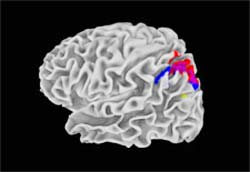Rare deficit maps thinking circuitry

3-D MRI scan rendering of the brain’s white matter (nerve fibers), showing small area (yellow) found to lack grey matter in people with Williams Syndrome. Impaired input from this area is thought to have resulted in lack of activation in downstream parts of the circuit, which processes locations of objects, when participants performed visual-spatial tasks, such as paying attention to locations of faces and houses (red), assembling puzzle-like pieces and matching geometric objects (blue). Overlap regions are shown in purple. Source: Shane Kippenhan, Ph.D., <br>NIMH Clinical Brain Disorders Branch
Using brain imaging, neuroscientists at the NIH’s National Institute of Mental Health (NIMH) have pinpointed the site of a defect in a brain circuit associated with a specific thinking deficit. Their study demonstrates how a rare genetic disorder, Williams Syndrome, can offer clues as to how genetic flaws may translate into cognitive symptoms in more common and complex major mental disorders. Andreas Meyer-Lindenberg, M.D., Karen Berman, M.D., and colleagues, traced the thinking deficit to a circuit at the back of the brain that processes locations of objects in the visual field. The researchers report on their Magnetic Resonance Imaging (MRI) study in the September 2, 2004 Neuron.
The study focused on the inability to visualize an object as a set of parts and then construct a replica, as in assembling a puzzle – a key cognitive deficit experienced by people with Williams Syndrome. In addition to this visuospatial construction deficit, people with Williams Syndrome also tend to be overly friendly and anxious and often have mental retardation and learning disabilities. Compared to most mental disorders, which are thought to involve complex interactions between multiple genes and environmental triggers, the genetic basis of Williams Syndrome is remarkably well understood. People with the disorder lack about 21 genes in a particular part of chromosome 7.
“Williams Syndrome yields a unique opportunity to study how genes influence our ability to construct our social and spatial worlds,” said NIMH Director Thomas Insel, M.D. “By studying people with this disorder, we can discover how genetic mutations change not only molecular and cellular processes, but lead to differences in the brain circuitry for complex aspects of cognition.”
To identify where in the brain things go awry in the visuospatial construction deficit, Meyer-Lindenberg and Berman recruited 13 “high functioning” Williams Syndrome patients with normal intelligence. Even though they were missing the same genes as their mentally retarded peers, they were able to perform complex cognitive tasks during functional MRI (fMRI) experiments, and their brain structure and activity could be compared with matched healthy controls of similar IQ.
The researchers suspected that the visuospatial construction deficit would be found in a visual processing circuit that courses forward and upward from the back of the brain. This “where” circuit processes information about locations of objects and spatial relationships, whereas a parallel “what” circuit, running downward from the back of the brain, handles information about content of objects.
In the fMRI phase of the study, participants were scanned while performing spatial tasks – matching geometric objects, assembling puzzle-like pieces into a square, and attending to the location of faces and houses. In each case, only those with Williams Syndrome failed to activate the “where” circuit, while the controls showed increased activation in that circuit. The patients’ brains showed no difference from controls on tasks that activated the “what” circuit.
Using structural MRI, the researchers found a small region early in the “where” circuit that lacked gray matter (neuron bodies) in the Williams Syndrome participants. Its location – conspicuously just before the functionally abnormal areas – raised suspicions; and a path analysis confirmed that the functional abnormalities could be accounted for by defective input from this structurally abnormal area. The researchers hypothesize that it is likely the primary site of the visuospatial construction deficit. They are now attempting to trace the deficit to individual genes in this structurally abnormal area.
“The location of the abnormality also suggests a strategy for improving visual-spatial-construction function,” noted Meyer-Lindenberg. “It is like a roadblock, but it should mainly affect stimuli that don’t move. Incorporating motion into stimuli might provide an alternate route and circumvent the problem by engaging temporal lobe circuitry.”
Media Contact
More Information:
http://www.nih.govAll latest news from the category: Life Sciences and Chemistry
Articles and reports from the Life Sciences and chemistry area deal with applied and basic research into modern biology, chemistry and human medicine.
Valuable information can be found on a range of life sciences fields including bacteriology, biochemistry, bionics, bioinformatics, biophysics, biotechnology, genetics, geobotany, human biology, marine biology, microbiology, molecular biology, cellular biology, zoology, bioinorganic chemistry, microchemistry and environmental chemistry.
Newest articles

Parallel Paths: Understanding Malaria Resistance in Chimpanzees and Humans
The closest relatives of humans adapt genetically to habitats and infections Survival of the Fittest: Genetic Adaptations Uncovered in Chimpanzees Görlitz, 10.01.2025. Chimpanzees have genetic adaptations that help them survive…

You are What You Eat—Stanford Study Links Fiber to Anti-Cancer Gene Modulation
The Fiber Gap: A Growing Concern in American Diets Fiber is well known to be an important part of a healthy diet, yet less than 10% of Americans eat the minimum recommended…

Trust Your Gut—RNA-Protein Discovery for Better Immunity
HIRI researchers uncover control mechanisms of polysaccharide utilization in Bacteroides thetaiotaomicron. Researchers at the Helmholtz Institute for RNA-based Infection Research (HIRI) and the Julius-Maximilians-Universität (JMU) in Würzburg have identified a…



